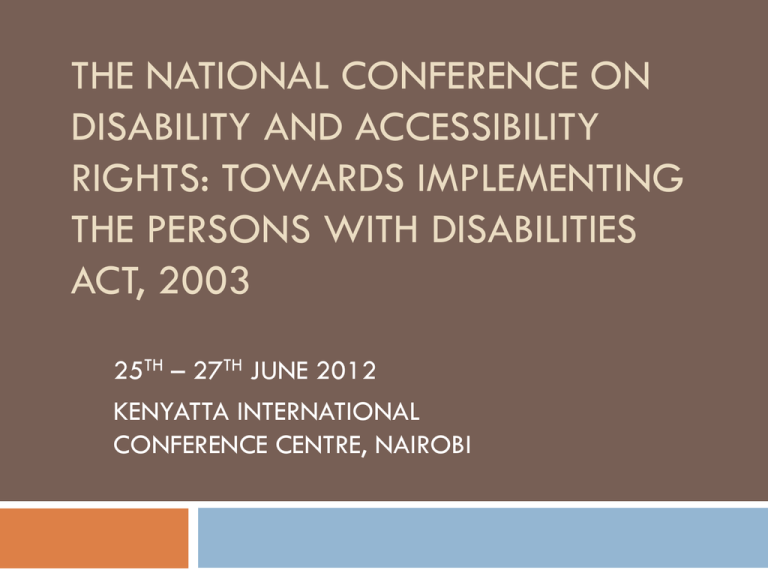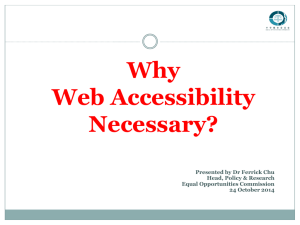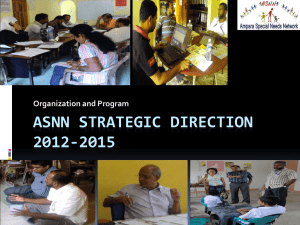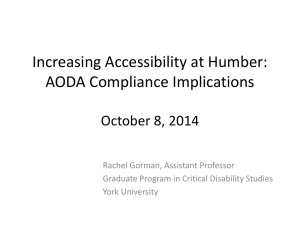INCORPORATING DISABILITY IN ARCHITECTURE
advertisement

THE NATIONAL CONFERENCE ON DISABILITY AND ACCESSIBILITY RIGHTS: TOWARDS IMPLEMENTING THE PERSONS WITH DISABILITIES ACT, 2003 25TH – 27TH JUNE 2012 KENYATTA INTERNATIONAL CONFERENCE CENTRE, NAIROBI INCORPORATING DISABILITY IN ARCHITECTURE – WHERE ARE WE? A PRESENTATION BY ARCH. STEVEN OUNDO CHAIRMAN ARCHITECTURAL ASSOCIATION OF KENYA INCORPORATING DISABILITY IN ARCHITECTURE Where are we? Very far. That is reality… How do we perceive disability? all human beings have a different mix of abilities regardless of their physical or mental state. It is therefore safe to support the assertion that there are no disabled persons – rather Persons with different abilities How do we perceive disability? The World Health Organisation (WHO) has also redefined disability. According to WHO, disability can no longer be viewed as a fixed physical or mental state but as a contextual variable. The state of Disability is dynamic – changing over time and in relation to circumstances. One is more or less disabled based on the interaction between the person and the individual, institutional and social environments. (WHO) How do we perceive disability? Common example – pushing a baby pram can be considered a form of ‘disability’ What has been the problem? We have not adopted a human centered approach to Design of buildings and other facilities. Many public building (including very large complexes) have been designed and developed without incorporating the needs of all persons who will need to use the facility at one time or the other The Human Centered Approach to Design This is a broad concept that defines the approach taken in designing where a comprehensive analysis of the needs, wants and limitations of the end users of any product are given extensive attention and incorporated in design This approach is applied in the design of buildings, vehicles, equipment, appliances etc. Designers anticipate user requirements and design to meet the requirements rather than force users to adapt to predesigned products. Universal Design In recent times, there has been a gradual shift globally toward a new thinking in the design of buildings, technologies, equipment etc to meet the needs of all people. This is the Universal design movement The Universal Design Movement Universal Design – is concept that proposes that the design (products, technologies, and the built environment) should serve the broadest range of people, regardless of levels of ability or mobility, age, gender, or physical stature without the need for adaptation or specialized design." The Universal Design Movement Based on the finding that designs of buildings, equipment and technologies to accommodate people with disabilities actually benefited everyone. Recognition that many such features could be commonly provided and thus less expensive, attractive. Principles of Universal Design Equitable Use: The design does not disadvantage or stigmatize any group of users. Flexibility in Use: The design accommodates a wide range of individual preferences and abilities. Simple, Intuitive Use: Use of the design is easy to understand, regardless of the user's experience, knowledge, language skills, or current concentration level. Perceptible Information: The design communicates necessary information effectively to the user, regardless of ambient conditions or the user's sensory abilities. Principles of Universal Design Tolerance for Error: The design minimizes hazards and the adverse consequences of accidental or unintended actions. Low Physical Effort: The design can be used efficiently and comfortably, and with a minimum of fatigue. Size and Space for Approach & Use: Appropriate size and space is provided for approach, reach, manipulation, and use, regardless of the user's body size, posture, or mobility. (© Center for Universal Design, School of Design, State University of North Carolina at Raleigh [USA]) Key Challenges Accessibility to buildings Access within buildings Signage Sanitary facilities Safety All these areas have largely fallen short of expectation in meeting the needs of all users of buildings Accessibility to buildings: Designated parking facilities with wider parking space and clear signage Parking space should be as close as possible to building main entrance Continuous, obstacle free pathway – sufficient width to accommodate wheelchairs, walking frames etc Clear signage Accessibility within the Building Clear passage ways within the building with sufficient width Floor material – should be firm and non-slip Inclusion of handrails Safety kerbs / kerb rails to protect wheelchairs from rolling over passageways Clear and legible signage to direct all visitors Accessibility within the Building Doors and doorways– should be easy to open and Wide enough to allow wheelchairs, walking frames to go through. Signage – should be clear Design and layout – simple enough to facilitate ease of movement for all Accessibility within the Building Lifts: These are essential to accessibility within buildings – especially in a highrise urban environment Lifts should: Be large enough to accommodate wheelchairs and walking frames Should incorporate visual, audio and braille control and information system Other facilities Washroom facilities – Easily accessible designated toilet facilities with clear signage Accessible facilities such as taps, mirrors, shelves, changing rooms that are specifically designed for people with special needs. Specific consideration for safety for persons with disability – including fire alarms, fire exits, What is the situation in Kenya There are no statistics on compliance of buildings with minimum accessibility standards There are a number of buildings (especially the newer ones) that have incorporated universal accessibility. A good number of these are the result of post construction adjustment rather that part of initial design A vast majority , from experience, can be considered inaccessible to all A brief overview of development control in Kenya –Responsible entities DEVELOPER: who has the primary duty of care and has the responsibility of engaging certified professionals as consultants; CONTRACTOR GOVERNMENT: who is expected to have the capacity and competence to undertake the specific tasks for the specified scope of works through a number of regulatory agencies charged with enforcing bylaws and ensuring that any development meets stated regulatory building standards; CONSULTANTS: Consultants have a duty to advise the client on the various aspects of the project and to ensure that due process is followed during the entire project cycle. Challenges - Development Control There are challenges in the development control system in Kenya. This has compromised the ability of Local authorities to supervise & inspect building projects to ensure compliance with statutory requirements and regulations – raising serious safety concerns. Local Authorities in Kenya lack adequate technical capacities for approval, supervision and inspection of development projects to ensure compliance with existing laws. Challenges - Development Control Weak institutional and legal framework There are many Acts which are domiciled in different ministries/ state agencies that apply in development control of physical developments. For example, the Ministry of Land prepares physical development plans for the Local Authorities; the Local Authorities are empowered to implement these plans and undertake development control; and National Environmental Management Authority oversees issues on environment. This leads to lack of institutional coordination arising from different mandates in development control. Challenges - Development Control Low level of public awareness of development control policy framework The procedures that guide development control have not been sufficiently shared with the public – public awareness of planning policy is extremely low. This apparent lack of knowledge also directly impacts developers in their understanding of planning policy requirements, leading to poor development proposals, low levels of compliance and ultimately weak attempts at enforcement of planning policy as it exists. Challenges - Development Control Incompetent persons Local Authorities in Kenya have reported that unregistered persons are involved in development control stages and carry out over 50% of the development proposal preparation within the Local Authorities. Development proposals when implemented are then likely to be of the poor quality that we find manifest in much of urban Kenya. Challenges - Development approval This is attributed to multiplicity of factors including; absence of established development control departments/sections in most Local Authorities, inadequate budgetary allocation to hire the qualified personnel for development control activities, and an inability to retain qualified staff. (A study of the Development Control Framework in Kenya, © Architectural Association of Kenya, 2011) Challenge – Cost Implications This is perhaps the single most important factor that hinders development of inclusive built environment. Lifts, sanitary ware and other inputs are disproportionately expensive Examples – washroom facilities for persons with disabilities cost at least four times ordinary material Lifts cost as much as Ksh. 7.5million with attendant maintenance costs – making them only viable for high rise developments Opportunity - The National Construction Authority This has now been established under The National Construction Authority Act NO. 41 OF 2011 The Authority’s functions include: undertake or commission research into any matter relating to the construction industry; provide consultancy and advisory services with respect to the construction industry; promote and ensure quality assurance in the construction industry; National Construction Authority encourage the standardization and improvement of construction techniques and materials; initiate and maintain a construction industry information system; THE NCA PROVIDES AN EXCELLENT WINDOW OF OPPORTUNITY TO DEEPEN INTEGRATION OF ACCEESIBILITY IN ALL BUILDING PROJECTS RECOMMENDATION: Public awareness for attitude change : Public awareness campaign among all parties involved in the development process to recognise the benefits of, and endeavour to bring about inclusive design. RECOMMENDATION: Development Approval Build capacity of local authorities (development approval units) to enforce compliance with universal design guidelines. – Training of technical officers, enhance budgetary allocation to DC sections in all local authorities. Enforce compliance at DC level - Building plans that do not meet minimum standards of compliance should not be approved for development on such grounds RECOMMENDATION: Development Approval Incorporate accessibility section in the development approval process: all applicants to be required to declare, as part of application, specific interventions to include accessibility Issuance of occupancy certificates to be done only upon full compliance Recommendation - Building Audit Need to audit all buildings in Kenya. This will go a long way in helping us understand the magnitude of the problem and develop appropriate solutions. It will also help in gathering vital statistics that will inform policy discussion on matters related to the built environment. Recommendation – Tax Incentives While there are existing tax incentives extended to persons with disabilities, the government needs to consider further incentives on construction material that enhance accessibility within the built environment. The Architectural Association of Kenya Professional Centre, Parliament Road P.O. Box 44258-00100 NAIROBI aak@aak.or.ke www.aak.or.ke








